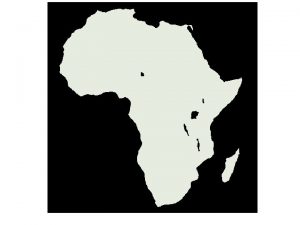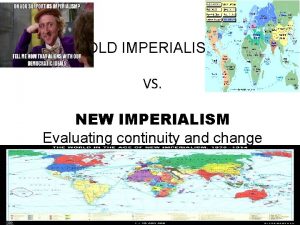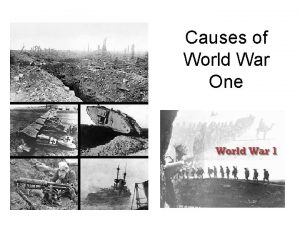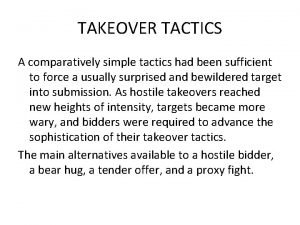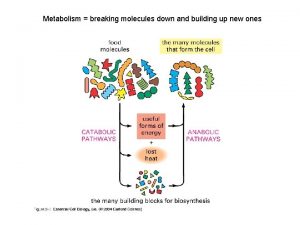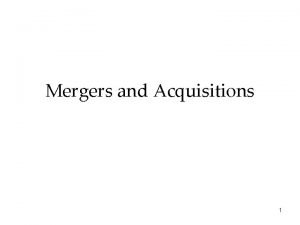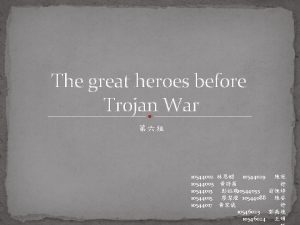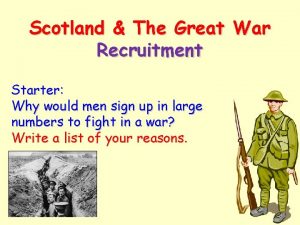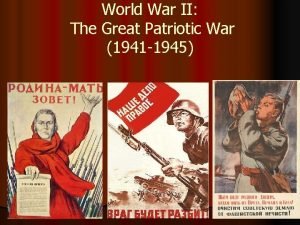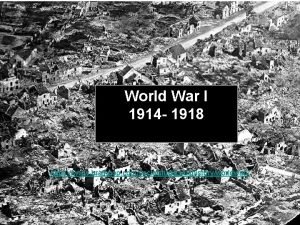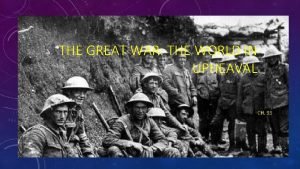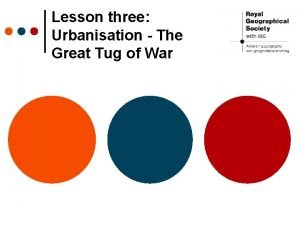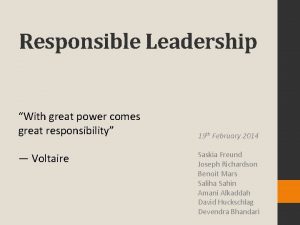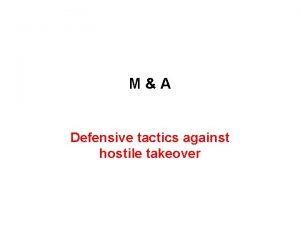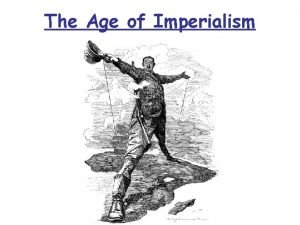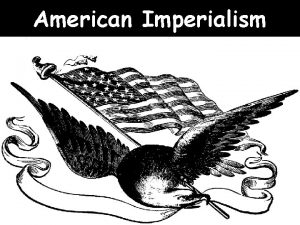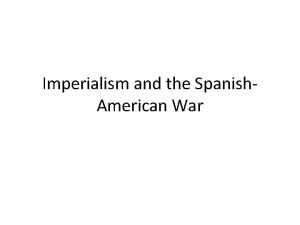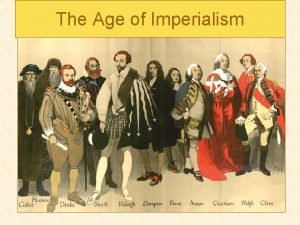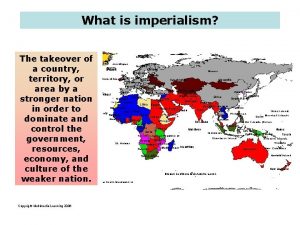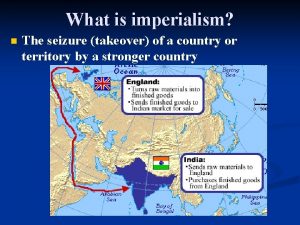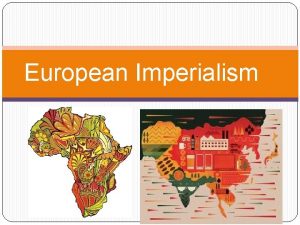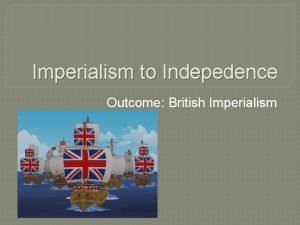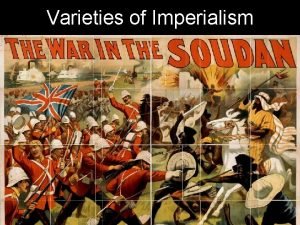THE GREAT WAR Imperialism defined as the takeover

































































- Slides: 65

THE GREAT WAR

Imperialism • defined as the takeover of a country by a more powerful country, usually spurred on by the following factors with the intent of building an empire “The sun never sets on the British Empire” (pink territory)

Causes of Imperialism • • the desire to exploit (take advantage of) natural resources • competition for territory between European nations • ethnocentricity (the belief that one’s culture or ethnicity is superior to other cultures or ethnicities) • “White Man’s Burden” (the duty of whites to uplift other cultures/races – to civilizes the “savages”) • the need foreign markets for European goods imperialism dominated the world stage during the late nineteenth and early twentieth centuries

Militarism & Nationalism There was a huge arms race in Europe in the early 1900’s Britain and Germany were going head to see who could create the larger navy Dreadnoughts British Navy’s Two Power Standard All European countries expanded their armies and empires to try and maintain a balance of power Militarism: A political situation in which military interests dominate government policy

Nationalism Two Types: State Nationalism: Strong feelings of patriotism and pride for one’s county or desire of a people to preserve its own language, religion and traditions Ex. “For God, Queen and Country” Ethnic Nationalism: Exits within an ethnic group that does not have its own country Ex. Led to break up of Austria Hungary


Alliances - Many countries formed alliances to protect themselves. - France, Russia, and Britain formed an alliance called the Triple Entente (which became known as the Allied Powers) - Germany, Austria-Hungary, and Italy formed the Triple Alliance (which became known as the Central Powers)

Countdown to WWI 1. Archduke Frans Ferdinand Princess Sophie 2. 3. 4. 5. Archduke Ferdinand is assassinated by the Black Hand while visiting Bosnia. Blank Cheque: Germany tells Austria-Hungary to deal with the situation using whatever means are necessary. Germany assumes Britain will remain neutral Austria-Hungary prepares for war Ultimatum: Austria tells Serbia to hand over its terrorists (i. e. Black Hand) Serbia’s Reply: Accepts most conditions. Seeks clarification. Austria sees this reply as a rejection Austria uses this “rejection” as an excuse to declare war on Serbia Gavrilo Princip of the Black Hand – Ferdinand’s assassin, is arrested http: //military. discovery. com/battles-history/videos/world-war-1 videos. htm

Countdown Continued… 6. Russia tells Serbia to fight back using what ever means are necessary 7. Russia thinks that Germany might be trying to take over Balkans Russia also mobilizes to strike at Germany declares War on Russia This draws France into the battle. 8. Germany declares War on France! 9. Schlieffen Plan - Germany’s plan to: prevent a two front War attack France through Belgium. Defeat the French and then move east to attack the Russians who would be slow (6 weeks) to respond to the attack on France. Belgium’s neutrality was protected by Britain. 10. Plan backfired - Britain declares War on Germany because they entered neutral Belgium WORLD WAR I (“The Great War”) Begins.

Schlieffen Plan http: //www. youtube. com/watch? v=l. JXAcl 8 D 51 Y&feature=related

Stalemate Germany encountered strong resistance as it moved through Belgium The Battle of Marne (Germany vs. France) slowed Germany down and allowed Russia to mobilize – creating the 2 front war that Germany hoped to avoid. British and French could not push Germany out of France. Germany could not advance. Both sides dug trenches and prepared for a long battle. The stalemate continued (no real progress made) for 3 years.

Trench Warfare Trenches were dug to offer protection from enemy fire Sometimes elaborate, but often muddy ditches filled with rotting bodies, rats, and lice. “no man’s land”- the territory between enemy trenches “going over the top”- entering no man’s land. Futile because many died from machine gun fire.

French soldiers try to move a wounded man along a communication trench on the Western Front.

Western Front




Trench Foot


Key Terms 1. Trench Warfare – type of fighting using ditches for protection 2. Battle of Attrition – type of battle where one side tries to outlast the other (by grinding down the other side) 3. Total War – All the resources of a nation are organized to meet the purpose of winning the war, including the “home front”

Technology Used in the Great War Machine Guns Accounted for most of the deaths in WWI


Poison Gas Chlorine gas was used for the first time in the Battle of Ypres (1915) Gas shells bursting



Tanks - not effective until near the end of the war. Could safely cross ‘no man’s land’


Tank and infantry advance

Submarines Germany used ‘U-boats’ to fire torpedoes at merchant ships supplying Britain with materials. The goal was to starve Britain into submission. German U-boats

German torpedo striking British steamer German Naval Mine

Airplanes Planes were in the experimental stages during WWI, and were not used as a main part of battles Some single pilot planes were used to scout enemy positions. “Dogfights” often occurred between pilots. Sometimes “Gunners” manned machine guns while pilots flew the planes



Artillery Guns


Canadian Uniforms & Ross Rifle

Important Canadian Battles

Battle of Ypres (1915) Canada’s first taste of trench warfare Canada was defending Ypres with the French. They retreated when the Germans used chlorine gas against them – first poison gas attack in history 6000 Canadians loss their lives John Mc. Crae wrote “In Flanders Fields” about the battle of Ypres

Ypres

Ypres

The Battle of the Somme (July, 1916) “Bloodbath” attempt to end trench warfare with a massive attack on German forces attack was unsuccessful – 20, 000 Canadian soldiers lost their lives Newfoundland Regiment suffered 90% casualties (only 68 of 700 survived)

Somme • Only a few km of territory gained • 1. 25 million total casualties (both sides total) • Allied shells were weak and could not penetrate enemy bunkers • Allies could not dislodge wires across no-man’s land • Allied troops overloaded with gear • A mine detonated 10 min before attack and warned Germans in advance • Attack occurred in broad daylight • Attack ordered to continue despite heavy casualties

Somme

Somme

Vimy Ridge (April, 1917) Canadians attack Germans 3 weeks of bombing preceded the attack to weaken the German defences Attack was well planned and practiced 3000 Canadians killed and 7000 injured Canadian forces were successful in capturing Vimy Ridge Key moment in Canadian independence and creation of Canadian identity British no longer in command Canadian forces

Vimy

Vimy

The Battle of Passchendaele (October, 1917) - Allied forces get bogged down in muddy conditions - Canadians asked to attack Germans – could not move in mud - General Currie (CAN) initially refused but was overruled - Canadians ordered to attack. Took the town and held it until reinforcements arrived - Only one out of every 5 Canadians survived - 16 000 Canadians died to take on 7 km of land

Australian soldiers walking on duck-boards at Passchendaele

asschendaele Passchendaele

https: //www. youtube. com/watch? v=2 Npwvx. RDon. U Passchendaele


The Russian Campaign, 1914 -1916 • • Russia surprised Germany by mobilizing faster then was anticipated Germans defeated Russian forces at Tannenberg, it was slaughter on an unprecedented scale However, German success on the Eastern Front contributed to the stalemate on the Western Front The Germans continued to advance into Russia until 1916

The Gallipoli Campaign, 1915 The Turks (Ottoman Empire) entered the war on the side of the Central Powers in an attempt to keep the Russians out of Gallipoli Britain wanted to control straits in order to open a supply line to Russia ANZAC (Aussies/Kiwis) forces were slaughtered, further demoralizing Allied forces

USA Enters the War German decision to implement unrestricted submarine warfare made US ships targets Lusitania sunk in 1915 In 1917, US learns that Germany was encouraging Mexico to attack the USA when they intercepted the famous Zimmerman Telegraph US Pres. Woodrow Wilson declares war on Germany in 1917 thus ending the US policy of “isolationism. ”

Wilson Political Cartoon

The Last 100 Days Treaty of Brest-Litovsk due to the Bolshevik Revolution in Russia, led by Lenin (1917), Russia signed this peace agreement with Germany, taking them out of the war, and allowing Germany to fight a one-front war Despite losing Russia, the allies remained strong due to the USA joining the war in April, 1917 n

The Last 100 Days cont’ 100 Days was the allied effort that finally broke the German military Canadians were at the forefront of the Allied advance November 11, 1918 Germany formally surrendered with the signing of an armistice (an agreement amongst warring countries to stop fighting and move to a peace conference).

1918 - Disaster and Horror J. M. Keyes (British Economist) “We are at the dead season of our fortunes. Our power of feeling or caring beyond the immediate questions of our own material well-being is temporarily eclipsed… We have been moved already beyond endurance, and need rest. Never in the lifetime of men now living has the universal element in the soul of man burnt so dimly”.

Paris Peace Conference Treaty of Versailles Most important international agreement of the 20 th century Allied powers met in Paris to decide what was going to happen to the defeated countries Pres. Wilson’s Fourteen Points would serve as the basis for negotiations in Paris The Big Three: • US President Woodrow Wilson • British PM David Lloyd George • French PM Georges Clemenceau

Treaty of Versailles War Guilt Clause Stated that Germany alone must accept responsibility for causing the war Included to justify the punishments that the allies wanted to inflict against Germany, including paying reparations (money) for damages (mostly to France) Caused the German people to protest, and the German Chancellor to resign In part a future cause of World War II – German people angry and humiliated, and Hitler used this to appeal to them to help him overthrow the German government n

Versailles cont’d Self-determination Ethnic groups would vote on the issue of whom they would prefer to live with or be governed by. In order to completely implement selfdetermination, it was necessary to create homelands for all of the different ethnicities in Europe. Redrawing the borders of Europe would prove to be a difficult assignment, one that led to the eventual break out of World War II.

Versailles Summary War Guilt Clause Alsace-Lorraine returned to France Poland given access to Sea – “Polish Corridor” All Central Powers’ colonies surrendered to League of Nations German army limited to 100, 000 men; navy and air force restricted in size

Versailles Summary Germany forced to surrender its entire merchant fleet as compensation to Allies for shipping loses in war West bank of Rhine River Valley (on border of France & Germany) was de-militarized (“Buffer zone”) Unification between Austria-Hungary and Germany was forbidden Constitution of League of Nations included

Canada & Treaty of Versailles (1919) IMPORTANT STEP IN CANADIAN INDEPENDENCE AND IDENTITY Prime Minister Borden insisted that Canada have its own seat at the Conference, and sign the Treaty separately from Britain Said Borden to Lloyd George: “The Dominions have fought in the war upon the principle of equal nationhood. That principle has been consecrated by the efforts and sacrifices of Canadian soldiers and it must be maintained. ”
 Old imperialism vs new imperialism
Old imperialism vs new imperialism Old imperialism vs new imperialism
Old imperialism vs new imperialism What is a collection of well defined objects
What is a collection of well defined objects Why was imperialism a cause of world war i
Why was imperialism a cause of world war i Friendly takeover
Friendly takeover Vertical merger
Vertical merger Takeover of a country by a stronger nation
Takeover of a country by a stronger nation Winter dam takeover
Winter dam takeover Witches
Witches Owasp top 20 automated threats
Owasp top 20 automated threats Corporate account takeover examples
Corporate account takeover examples Proxy fight
Proxy fight The creamy creations takeover case study
The creamy creations takeover case study Cequence bot protection
Cequence bot protection Types of takeover
Types of takeover Takeover evolution
Takeover evolution Phalippou private equity
Phalippou private equity War at home and abroad madison
War at home and abroad madison Korean war vietnam war venn diagram
Korean war vietnam war venn diagram The cold war lesson 1
The cold war lesson 1 Reconstruction plans venn diagram
Reconstruction plans venn diagram Was josette dugas pro war
Was josette dugas pro war Sein war
Sein war Contact force examples
Contact force examples Why was the civil war considered the first modern war
Why was the civil war considered the first modern war Perfect lizz
Perfect lizz Toward civil war lesson 3 secession and war
Toward civil war lesson 3 secession and war Sides in cold war
Sides in cold war Chapter 30 the war to end war
Chapter 30 the war to end war Chapter 30 the war to end war
Chapter 30 the war to end war The great heroes before the trojan war
The great heroes before the trojan war Why did so many scots volunteer to fight in the great war
Why did so many scots volunteer to fight in the great war Podagros
Podagros Great patriotic war
Great patriotic war Brainpop world war 1
Brainpop world war 1 The great war: the world in upheaval
The great war: the world in upheaval Chapter 13 the great war
Chapter 13 the great war Sandrine bertaux
Sandrine bertaux Which marked the end of the peloponnesian war
Which marked the end of the peloponnesian war Push and pull factors of urbanisation
Push and pull factors of urbanisation Great war ends
Great war ends Turning great strategy into great performance
Turning great strategy into great performance South dakota's state animal
South dakota's state animal With great power comes great responsibility
With great power comes great responsibility Great white hammerhead
Great white hammerhead Did alexander the great deserve to be called great
Did alexander the great deserve to be called great Frederick the great enlightened despot
Frederick the great enlightened despot With great expectations comes great responsibility
With great expectations comes great responsibility A great deal vs a great many
A great deal vs a great many With great power comes great responsibility
With great power comes great responsibility Does alexander deserve to be called the great
Does alexander deserve to be called the great Great is thy faithfulness oh god my father
Great is thy faithfulness oh god my father Hình ảnh bộ gõ cơ thể búng tay
Hình ảnh bộ gõ cơ thể búng tay Bổ thể
Bổ thể Tỉ lệ cơ thể trẻ em
Tỉ lệ cơ thể trẻ em Voi kéo gỗ như thế nào
Voi kéo gỗ như thế nào Chụp phim tư thế worms-breton
Chụp phim tư thế worms-breton Chúa yêu trần thế
Chúa yêu trần thế Các môn thể thao bắt đầu bằng tiếng nhảy
Các môn thể thao bắt đầu bằng tiếng nhảy Thế nào là hệ số cao nhất
Thế nào là hệ số cao nhất Các châu lục và đại dương trên thế giới
Các châu lục và đại dương trên thế giới Công của trọng lực
Công của trọng lực Trời xanh đây là của chúng ta thể thơ
Trời xanh đây là của chúng ta thể thơ Mật thư tọa độ 5x5
Mật thư tọa độ 5x5 Phép trừ bù
Phép trừ bù
